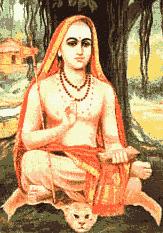BY LETTER
Advaita Vedanta
Popular monistic acosmic non-dualist mystical philosophy of Old Earth Hinduism. One of the principal Vedantic schools, Advaita was promulgated and taught by the sages Gaudapada and (2 generations later) Shankara (7th/8th century c.e. India, Old Earth). Asserts the existence of Brahman alone, whose appearance as the world is misperception (maya) resulting from metaphysical ignorance (avidya). Upon attaining liberation one realizes that the inner self is the same as God/Godhead.
Advaita exerted a tremendous philosophical and cultural influence on Indian society throughout the medieval and colonial period. During the late Atomic Age and throughout the Information Age, watered-down Advaitin-based philosophies, religions, and guru-based sects were very popular in the West, mostly incorporated into Nuage and other syncretic religions. The rise of the big Indian megacorps like Hindustan Astronautics with the emerging Indian superpower of the middle to late Information Age, and the spread of Hindu hi-tech ethnic groups in space during the early Interplanetary period helped with the revival of Advaita, which was frequently adopted as a matter of cultural pride, even by individuals who had little sympathy with or understanding of it.
With the later Mahayana, Cosmism, Sophism, and Nuagism became more predominant and the Advaitin meme was increasingly diluted, although it retained a hold in the old ethnic populations in the Sol System even as late as the Empires period. It also exerted a strong influence on some elements of Sophic memetics and religion.
Related Articles
Appears in Topics
Development Notes
Text by M. Alan Kazlev
Initially published on 31 December 2001.
Initially published on 31 December 2001.







